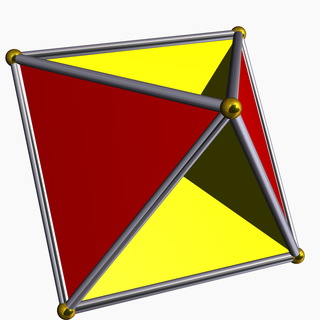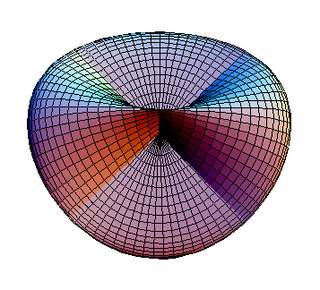Tetrahemihexahedron
Tetrahemihexahedron
Polyhedron with 7 faces
In geometry, the tetrahemihexahedron or hemicuboctahedron is a uniform star polyhedron, indexed as U4. It has 7 faces (4 triangles and 3 squares), 12 edges, and 6 vertices.[1] Its vertex figure is a crossed quadrilateral. Its Coxeter–Dynkin diagram is ![]()
![]()
![]()
![]()
![]()
![]()
![]() (although this is a double covering of the tetrahemihexahedron).
(although this is a double covering of the tetrahemihexahedron).
| Tetrahemihexahedron | |
|---|---|
 | |
| Type | Uniform star polyhedron |
| Elements | F = 7, E = 12 V = 6 (χ = 1) |
| Faces by sides | 4{3}+3{4} |
| Coxeter diagram | |
| Wythoff symbol | 3/2 3 | 2 (double-covering) |
| Symmetry group | Td, [3,3], *332 |
| Index references | U04, C36, W67 |
| Dual polyhedron | Tetrahemihexacron |
| Vertex figure |  3.4.3/2.4 |
| Bowers acronym | Thah |


The tetrahemihexahedron is the only non-prismatic uniform polyhedron with an odd number of faces. Its Wythoff symbol is 3/2 3 | 2, but that represents a double covering of the tetrahemihexahedron with eight triangles and six squares, paired and coinciding in space. (It can more intuitively be seen as two coinciding tetrahemihexahedra.)
The tetrahemihexahedron is a hemipolyhedron. The "hemi" part of the name means some of the faces form a group with half as many members as some regular polyhedron—here, three square faces form a group with half as many faces as the regular hexahedron, better known as the cube—hence hemihexahedron. Hemi faces are also oriented in the same direction as the regular polyhedron's faces. The three square faces of the tetrahemihexahedron are, like the three facial orientations of the cube, mutually perpendicular.
The "half-as-many" characteristic also means that hemi faces must pass through the center of the polyhedron, where they all intersect each other. Visually, each square is divided into four right triangles, with two visible from each side.
